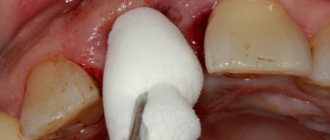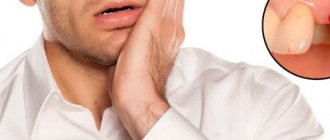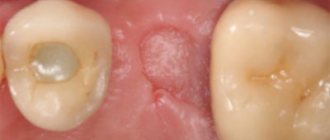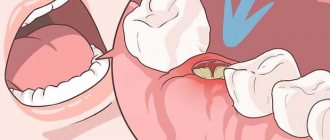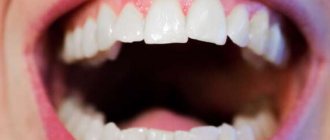A high-quality and rapid wound healing process after tooth extraction depends not only on the professionalism of the doctor who performed the extraction (removal) of the tooth, but on the correct behavior of the patient after the procedure, who must strictly follow the recommendations given by the doctor for the period of healing of the wound surface. If you correctly and clearly follow the advice of a specialist, the recovery process occurs quickly and as painlessly as possible.
For example, patients who do not listen to the recommendations given to them make rinsing movements in the area of the healing wound; this washes out the blood clot, which performs a protective function against the entry of bacteria and microbes, as a result of which there is a high risk of wound suppuration.
In this article we want to give recommendations on what should and can be done after tooth extraction, and what should not be done.
1. A gauze swab on the hole. When can it be taken out?
As a rule, the doctor does not immediately release the patient after removal, but asks him to wait for 15-20 minutes within the clinic to then examine and make sure that everything is in order with blood clotting and the tampon can be removed without fear. In rare cases, keeping the tampon in your mouth may take 30-40 minutes, usually 10-20 minutes. There is no need to keep it longer and it is even dangerous, because bacteria accumulate on it and there is a possibility of infection. There are exceptions, when the wound continues to bleed a little, then the old tampon is replaced with a new sterile one and kept for some time.
For some time, saliva may still be pinkish due to staining with secreted ichor, this should not be alarming, this situation can be distinguished from bleeding. At this moment, saliva can be easily swallowed; there is no need to accumulate it in the mouth.
Taking antibiotics after the procedure
Dentists quite often resort to antibiotics in the postoperative period, especially after tooth extraction. But not every patient who has undergone tooth extraction requires antibiotics. They are prescribed only in the following cases:
- Ear hurts after wisdom tooth removal
- if the patient experiences inflammatory processes in the gum area;
- if the patient is elderly;
- if complications arise during the operation or features of the anatomy of the teeth are revealed, which contributes to more extensive trauma;
- if the patient has a reduced immune system or suffers from any blood diseases.
Sometimes antibiotics are necessary
This list is not all the reasons for prescribing antibiotics in the postoperative period, because each individual case has its own characteristics. An experienced dentist will be able to easily determine which patient needs to take medications after tooth extraction. The doctor must determine the duration of administration and dose individually for each case. Most often, the course of taking the drug after tooth extraction lasts from five to seven days. In rare complicated cases, treatment can last up to fifteen days. It is simply impossible to determine the average dose of antibiotics that is needed, since each individual drug has its own individual characteristics.
Important ! It is strongly recommended not to take antibiotics unless prescribed by a doctor.
In addition to antibiotics, your doctor may also prescribe medications to normalize the microflora after taking antibiotics. The most commonly prescribed drug is Linex, but sometimes other drugs from the group of probiotics are also prescribed.
"Linex"
Video: Antibiotics after tooth extraction
2. After what time can you eat and drink?
After removal, you can drink water. After two hours you can eat. The limiting condition is not to chew rough food on the side of the extracted tooth in the first few days. Hard food can damage the blood clot, which is located in the socket and is needed for wound healing. If the patient experiences an acute feeling of hunger, then no one forbids eating cool yogurt or kefir. In the first days of healing of the hole, it is better to completely avoid eating rough, hard, solid foods, so as not to make strong chewing movements, as well as spicy, salty foods, so as not to irritate the oral mucosa. It is also important to monitor the temperature of food and drinks; they should not be too hot.
How long does it take for a hole to heal?
The wound left after tooth extraction has a certain healing pattern.
- After the tooth extraction procedure is completed, the circular ligament located around the crown of the extracted tooth begins to contract.
- A short amount of time after the procedure, you may notice an accumulation of blood in the hole. The resulting clot helps protect the wound from infection or small food particles. Over time, the hole begins to become overgrown with fibrous tissue.
- After a certain amount of time, which depends on the characteristics of the human body, as well as on the correct care of the hole after the procedure, the surface of the wound heals and the affected area of the gum is restored.
- After this, over time, new epithelium grows on the surface of the gum, as well as the development of bone tissue at the site of tooth extraction.
The hole will heal after two to three weeks
Important ! The normal healing of the hole is facilitated by the medicine that is placed in the hole. Without it, the wound will not heal.
Many patients worry about the healing of the wound that remains after tooth extraction. The doctor must explain to the patient that the wound can heal completely only after two or three weeks, provided that all care rules are followed. If they were nevertheless broken or an infection was still able to penetrate the wound, then with repeated disinfection, complete restoration of the affected area will occur in five months.
What is allowed during the healing period?
- Non-solid semi-liquid food.
- Gentle oral hygiene.
What is prohibited during the healing period?
- Drinking alcohol and smoking cigarettes.
- Drinking liquids with a plastic straw.
- Harsh brushing of teeth in general and especially in the healing area.
- Eating dry and solid food.
- Sudden movements of the cheekbones for one week after the procedure.
During the healing period of the hole, you should not eat solid food.
3.Applying ice.
After tooth extraction in our Center, a specialist will give you ice specially prepared for such procedures to apply in the first hours after extraction. Ice is applied for a certain time, at certain intervals, which the doctor will instruct you about. At home, this procedure will need to be continued for some time (the first few hours after removal). This is done in order to minimize or completely eliminate tissue swelling.
Under no circumstances should you heat the area in the area of the extracted tooth; in this case, suppuration will develop.
What is allowed to drink
The drinking regime after tooth extraction should also be gentle. The reasons for this are similar to dietary restrictions. The liquid washes out the hole, making room for bacteria and inflammation, and also brings additional pain while drinking. But water is very important for recuperation, so within a couple of hours after leaving the dentist you can take a few sips of cool water.
In the first days after surgery, you are allowed to drink warm (not hot!) tea, coffee, non-sour compote, juice, and plain water. It is recommended to abstain from carbonated drinks and concentrated juices and fruit drinks for several days. You need to drink in small sips directly from the glass. Some do this through a straw to prevent fluid from getting into the wound. But this is wrong, because during retraction, additional jaw movements are made, which can open the wound and cause pain.
You should also not rinse your mouth while drinking, especially on the first day after tooth extraction. This can be done with special herbal antiseptic solutions, carefully and carefully. But recommendations regarding rinsing should be given by a doctor; in some cases they are strictly contraindicated.
6. Medications after removal.
After the procedure, the doctor prescribes a number of medications to take. Under no circumstances should you take any medications on your own, without consulting a doctor.
Painkillers should be taken in case of pain, at intervals and in the amount recommended by the doctor. Each case is individual; it happens that the patient does without taking painkillers.
Antibiotics. In some cases, after removal, antibiotics are prescribed for 5-7 days. As a rule, these are situations when the doctor removes a tooth in the stage of inflammation, complex extraction or removal of several units of teeth. Only a specialist surgeon decides whether to take antibiotics or not.
Antihistamines. Reduces the likelihood of swelling.
Antiseptics. Used as a rinse. BUT, remembering that rinsing movements are prohibited in the first days. A small amount of solution is taken into the mouth and simply held in the mouth, then calmly spit out. Such baths must be done if the tooth was removed during the inflammation phase, if the flux was exposed, if there are teeth affected by caries in the oral cavity.
How is the affected tooth removed?
The procedure itself should only be performed by an experienced surgeon and only when other treatment methods can no longer help. There are a number of reasons that can trigger the removal of an affected tooth:
- if the crown of the tooth is completely destroyed;
- when the patient is indicated for prosthetics;
- if complications arise during the eruption of a wisdom tooth;
- if filling requires perforation of the root canal.
A tooth can be removed for many reasons
Important ! There are cases when there is every reason to remove a tooth, but the patient has contraindications to this. In such cases, most often the intervention is carried out within the walls of a hospital with subsequent monitoring of the patient’s condition.
There are a number of main contraindications to surgical tooth extraction. These include:
- previous heart attacks;
- high blood pressure;
- arrhythmia;
- blood diseases;
- mental problems or neurological diseases.
There is a certain scheme for tooth extraction
If no contraindications have been identified in a patient who needs surgical removal of the affected tooth, then he is referred to the procedure itself, which should be carried out according to the following scheme.
| Stage | Description |
| Visit doctor | Before performing the procedure, the doctor must find out whether the patient has allergic reactions to any anesthetics, cardiovascular pathologies, or whether the patient suffers from hypertension. |
| Anesthesia | After all the necessary information has been obtained, the patient is sent for anesthesia. A fairly large number of different means are currently used to remove teeth. Their duration of action is from forty minutes to three hours. |
| Preparation | Next comes preparation for the intervention itself: in order not to injure the gum during manipulation, it first peels off from the tooth bone by at least five millimeters. This procedure is carried out using a special tool. The surgeon places special forceps on the tooth, and then begins to swing the tooth itself with them in order to destroy the ligaments attached to the jaw bone. |
| Removal | The affected tooth itself is pulled out, that is, extraction. After the affected tooth has been removed, the resulting hole must be thoroughly examined. This is necessary so as not to leave tooth fragments or a cyst in the wound cavity. If the extraction of the affected tooth took place in the presence of flux, then after its removal the gums are cut in the right place and the pus is released. After this manipulation, a drainage is inserted into the wound cavity. |
| Treatment | After the procedure is completed, you need to treat the wound itself. If pus is found at the site of the lesion, then in this case the hole must be washed with an antiseptic solution, and then an anti-inflammatory agent should be placed in the wound. If the hole itself is too large after extracting the tooth, then a suture is necessary. |
| Consultation | After the procedure has been completely completed, before discharge, the doctor must instruct the patient in detail on how to care for the hole during the healing period, and also prescribe any medications if necessary. |
After the tooth is removed and before the patient goes home, the doctor inserts a special medicine into the tooth socket. It is necessary to protect the wound from various influences, as well as for faster and more proper healing. Some patients complain that the turunda with the medicine interferes greatly, but this will have to be endured.
Important ! If you remove the turunda ahead of time, serious complications may develop, which will have to be dealt with not only by the dentist, but also by other doctors.
A special medicine is placed in the hole
The doctor prescribes exactly the medicine that is safe for every person. True, it does not have the most pleasant taste, but a person will have to ignore this factor if he wants the wound to heal as quickly as possible.
There are exceptional cases when it is simply impossible to remove the affected tooth according to the scheme above. The reason for this may be the following factors:
- How long does it take for drugs to leave the body?
- if the tooth root is crooked;
- if the bone tissue of the tooth is too fragile;
- if the crown of the affected tooth is already completely destroyed;
- if the figure eight is in a position of incomplete eruption or in a horizontal position.
If a patient who needs tooth extraction has any of these characteristics, then the intervention is performed in a different way. First, the gum is cut and peeled away from the bone. After this, the specialist drills out the desired area using a drill, which creates access to the root of the required tooth.
Important ! In some cases, the partitions between the roots of the tooth are sawed, after which each root is removed one by one.
In some cases, the tooth is removed differently
After such procedures, healing is more difficult and longer. Such an intervention may cause the patient to develop stomatitis. In many cases of such intervention, a secondary infection is attached to the affected area.
However, no matter which tooth is removed, medicine must be placed in the hole. This procedure is required.
7.High blood pressure.
In patients with high blood pressure, there is a risk that the wound may bleed longer than usual. In this case, you need to regulate the pressure by taking appropriate medications to reduce it. In our SDent dental medical center, even before the start of manipulations, the doctor always finds out the main points about the general health of the patient. If the patient has hypertension, the specialist knows about this problem in advance and then gives the necessary recommendations appropriate to the case.
Before surgery
Removing any tooth is a complex procedure that can only be performed by a dental surgeon. In some budget clinics during the summer holidays, tooth extraction can be entrusted to a dentist-therapist, but the patient should know that specialists in this profile do not have a sufficient level of practical skills, so if there is no urgent indication for surgery, it is better to wait for a highly specialized doctor or go to another dental clinic .
Before the operation, the patient must fill out a questionnaire in which he must indicate all the data that may affect the choice of medications, extraction method and other issues related to this type of dental treatment.
Before tooth extraction, the patient fills out a questionnaire and consults with a doctor
Mandatory information that must be reported to the doctor before surgery:
- blood type and Rh factor;
- having an allergic reaction to chemicals or certain medications;
- past illnesses;
- the fact of donor blood transfusion;
- bad habits (smoking and alcohol abuse).
It is important that the dentist receives reliable information
Note! It is very important to provide only truthful information so that the doctor has a complete understanding of the patient’s health condition and can assess possible risks. It is also necessary to indicate the telephone numbers of relatives with whom the doctor can contact if any complications arise (for example, from the heart and vascular system).
8.What happens to the sutures after removal.
After the tooth is removed, the surgeon places sutures on the wound surface. This promotes faster healing, reduced pain, less risk of inflammation, minimizes the risk of bleeding, and protects the blood clot from falling out.
At the SDent clinic we use the most modern and safe materials. The thread with which the surgeon sews the edges of the hole is self-absorbing. But during the process, the ends of the thread can cause discomfort to the patient and interfere with the oral cavity. Therefore, for the comfort and safety of the patient, the doctor always sets an appointment date for examination and removal of sutures in approximately 10 days.
Can I drink beer?
The same rules apply to beer as to other alcoholic beverages. Even though the concentration of ethyl alcohol in beer is lower than in other drinks, its consumption can cause more serious harm. The fact is that any beer contains yeast, which promotes the spread of pathogens and is an excellent breeding ground for unicellular fungi. In patients who cannot stop drinking beer after tooth extraction, the risk of stomatitis, alveolitis and other inflammatory processes will be almost four times higher than those who follow the regimen prescribed by the doctor.
After tooth extraction, you should not even drink non-alcoholic beer.
Removing any tooth is a complex, painful and unpleasant procedure, after which the patient requires a serious recovery period and a special diet and hygienic care. In order not to create additional stress on the injured gum and to avoid inflammation, it is necessary to avoid eating for 2-3 hours after surgery. A person will be able to return to their usual diet after the wound has completely healed, and postoperative complications will be excluded.
After tooth extraction, you should not do the following.
- In the first couple of days, taking a hot bath is excluded, only a warm shower.
- During sleep, you need to be careful not to lie on the side where the tooth was removed, this provokes the appearance of swelling.
- Visiting the gym and active physical activity should be postponed in the first days.
- Do not touch the wound with your tongue or foreign object.
- Do not open your mouth very wide, do not use active chewing and facial movements to avoid the sutures coming apart.
- Aspirin is not suitable as an anesthetic due to the fact that it has a thinning effect on the blood and may cause bleeding and hematoma.
- Do not rinse during the first few days. This can negatively affect the loss of a blood clot from the socket and the occurrence of inflammation.
For more information and to make an appointment with a specialist, call:
+7,
In what situations should you consult a doctor?
During rehabilitation after tooth extraction, the patient may experience a number of postoperative symptoms: swelling of the cheeks and gums, increased body temperature, pain in the area of the operation, discomfort when opening the mouth. During this period, it is especially important to monitor symptoms that are not the body’s natural reaction to surgery and can lead to serious complications: alveolitis, prolonged bleeding, limited osteomyelitis of the tooth socket, and others.
|
You should immediately consult a doctor if:
- The pain persists for longer than 3 days, intensifies, and radiates to the ear and neck. Painkillers prescribed by a specialist do not help. Normally, the pain should gradually recede and completely disappear after 1-3 days.
- Heavy bleeding does not subside within an hour, but continues several hours after surgery.
- The tampons stopped the bleeding, but after a while the bleeding resumed.
- Swelling and hematomas do not subside, but persist and intensify for 4 days or longer. Or they slept and then appeared again.
- The socket visually looks empty and dry, a blood clot has not formed or its integrity has been compromised - “dry socket” syndrome .
- Instead of a natural white coating, a dark gray, yellowish or greenish coating has formed on the wound.
- Instead of transparent ichor, which can ooze from the wound during the first day, cloudy pus with an unpleasant odor appears.
- Temperatures above 38°C last more than two days in a row. Or she slept, and then got up again.
- Lost appetite, weakness and nausea appeared.
- Painful sensations appeared when breathing and blowing your nose.
- The anesthesia should have worn off 2-3 hours after the operation, but the upper or lower jaw, part of the gums, cheeks or lips were numb for more than a day.
- Pain when opening the mouth and swallowing does not go away even 3–4 days after extraction [1, 2].
In order for tissue restoration to proceed without complications, it is important to carefully monitor the appearance of any symptoms and follow the doctor’s recommendations on when and what to eat after tooth extraction.
List of sources:
- Surgical dentistry and maxillofacial surgery. National leadership / Ed. A. A. Kulakova, T. G. Robustova, A. I. Nerobeeva. - M.: GEOTAR-Media, 2010. - 928 p. — (Series “National Guidelines”) // URL: https://dental-ss.org.ua/load/kniga_stomatologia/khirurgicheskaja/khirurgicheskaja_stomatologija_i_cheljustno_licevaja_khirurgija_nacionalnoe_rukovodstvo/10-1-0-594 (date of access: 07/17/2020)
- Memo of recommendations for patients after extraction (removal) of teeth // Website of the central city dental clinic in Grodno. URL: https://www.cgsp.by/zdorovyj-obraz-zhizni/27-buklety-listovki/280-pamyatka-rekomendatsii-patsientam-posle-ekstraktsii-udaleniya-zubov (date of access: 07/17/2020)
- Rehabilitation in maxillofacial surgery and dentistry: collection. tr. Rep. scientific-practical conf. with international participation in “Parin Readings 2012” (May 3-4, 2012) / under the general. ed. prof. I. O. Pokhodenko-Chudakova; redol. I. M. Bayrikov [and others]. – Minsk: Publishing house. center of BSU, 2012. – 486 p. URL: https://www.bsmu.by/downloads/kafedri/k_stom_hir/sbornik.pdf (access date: 07/17/2020)
What is allowed to eat
One day after the operation, you can eat soft and warm food. It is recommended not to consume fried, spicy and salty foods. This is because such dishes can lead to injury to the socket or irritation of the gums. The temperature of the food consumed should not be high. Recommended drinks to drink:
- dairy products;
- compotes;
- natural juices;
- still mineral water.
It is better to hold off on drinking hot coffee, tea or very cold drinks with ice.
